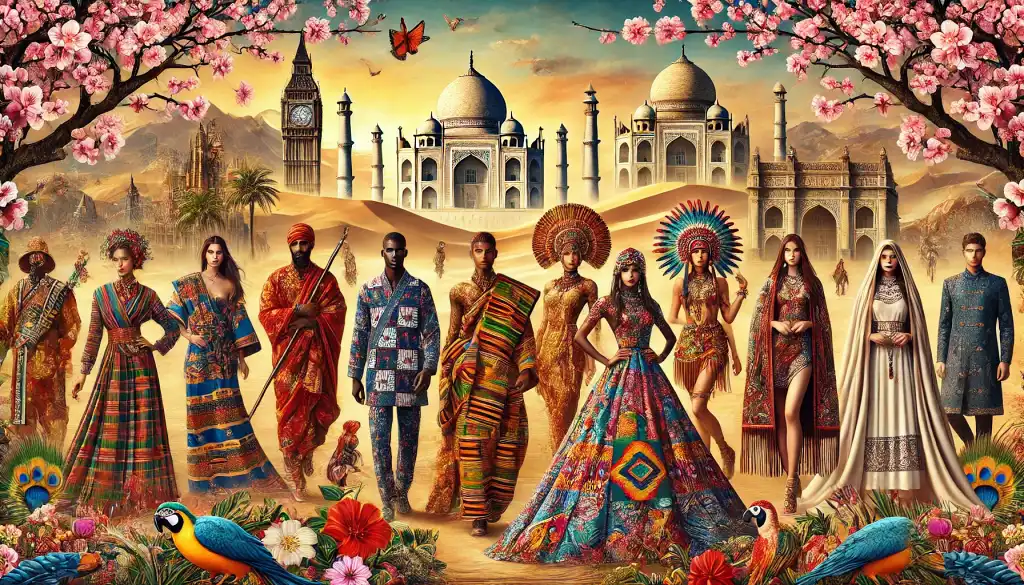Color is one of the most powerful tools in fashion, transcending borders and bridging the gap between tradition and innovation. From the vibrant hues of African textiles to the understated elegance of Japanese aesthetics, each culture offers a unique perspective on how colors shape identity, tradition, and style. In modern fashion, designers draw from these rich cultural tapestries to create collections that celebrate diversity and heritage while reimagining them for contemporary audiences.
This journey across the globe is as vast as it is fascinating. Each region carries its own deeply rooted history of color symbolism, with shades often representing joy, sorrow, spirituality, or status. To explore this fully would require more than a single article. Instead, we’ll delve into select regions, highlighting some of the most iconic and influential examples of how colors have inspired and continue to inspire the global fashion scene.
Let us embark on this vibrant exploration, moving across continents to uncover the stories, traditions, and modern interpretations of colors from around the world.
Asia: The Vibrancy of Tradition and Elegance
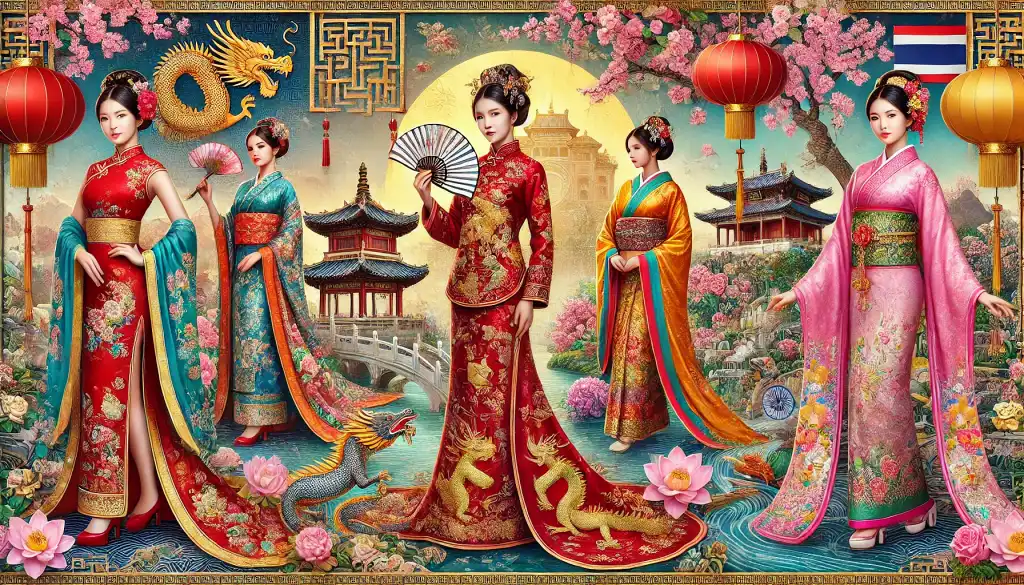
Asia, the largest and most diverse continent, offers a treasure trove of color symbolism and traditional artistry that continues to inspire global fashion. From the fiery reds of Chinese celebrations to the serene whites of Japanese minimalism, Asia’s palette is as varied as its landscapes.
China: Red for Joy and Prosperity
Red is deeply ingrained in Chinese culture, symbolizing luck, happiness, and prosperity. This vivid color dominates festivals like Chinese New Year, where lanterns, envelopes, and traditional attire burst with vibrant shades of scarlet. Bridal dresses (qipao or cheongsam) in red silk, often adorned with gold embroidery, are a timeless symbol of joy and union.
The symbolism extends to traditional motifs embroidered in gold thread, such as dragons (power and strength) and phoenixes (harmony and grace), which are integral to Chinese design. Contemporary designers like Guo Pei have elevated these traditions to the international stage. Her iconic golden cape, famously worn by Rihanna at the 2015 Met Gala, was a masterpiece inspired by imperial China.
India: A Celebration of Vibrant Hues
In India, colors are a vital part of cultural and spiritual expression. The traditional sari, often crafted from silk and embellished with gold thread, comes in a rainbow of colors—each carrying its own significance. Red signifies marriage and fertility, yellow is associated with joy and learning, while green is linked to new beginnings and harmony.
The art of dyeing fabrics in India is as old as its civilization. Techniques like bandhani (tie-dye) from Rajasthan and kantha embroidery from Bengal bring intricate patterns to life. Gold zari work, particularly from Varanasi (Banarasi silk), has become synonymous with opulence and weddings.
Designers like Sabyasachi Mukherjee have taken these traditions global. His creations, blending antique textiles with modern couture, showcase India’s rich heritage while appealing to international audiences. The lavish colors of Indian festivals like Holi and Diwali, where streets are filled with bursts of saffron, magenta, and indigo, often serve as inspiration for seasonal collections.
Japan: The Harmony of Minimalism
Japanese aesthetics revolve around simplicity, balance, and a profound connection to nature. These principles are reflected in their color palette, which often features soft pastels, earthy tones, and striking contrasts of black and white. The philosophy of wabi-sabi, emphasizing the beauty of imperfection and impermanence, deeply influences both traditional and contemporary Japanese fashion.
One of the most iconic symbols of Japan, the cherry blossom (sakura), embodies ephemeral beauty with its delicate shades of pink. These colors inspire traditional garments like kimonos, where patterns often depict seasonal flowers, cranes, or landscapes. Formal kimonos worn during weddings or festivals feature vibrant reds and golds, while somber occasions call for muted greens, browns, or blacks.
Japanese dyeing techniques like shibori (tie-dye) and kasuri (ikat weaving) create subtle gradients and intricate patterns. Designers such as Yohji Yamamoto and Rei Kawakubo have translated these traditions into avant-garde designs that redefine global minimalism. Yamamoto’s monochromatic collections focus on texture and structure, while Kawakubo’s creations explore abstraction, often with bold pops of color.
Southeast Asia: Sunset Shades and Tropical Vibrancy
Southeast Asia bursts with a color palette inspired by its lush rainforests, golden beaches, and radiant sunsets. Traditional attire like the Thai chut thai, Indonesian batik, and Vietnamese ao dai often features bright oranges, emerald greens, and deep turquoises, symbolizing prosperity, spirituality, and the natural world.
Batik, a wax-resist dyeing technique from Indonesia, is renowned for its elaborate patterns depicting flora, fauna, and cultural motifs. Coastal regions favor brighter hues, while Central Java is known for earthy tones. Batik is so culturally significant that UNESCO recognizes it as an intangible cultural heritage.
In Thailand, shimmering silk garments are dyed in sunset-inspired shades like saffron and gold. These fabrics are often used in ceremonial attire and reflect the spiritual significance of colors in Buddhist culture. Meanwhile, the ao dai in Vietnam, a graceful long tunic paired with trousers, often incorporates patterns of lotus flowers and bamboo in vibrant colors, symbolizing purity and resilience.
International designers have frequently drawn on Southeast Asia’s vibrant aesthetic. Oscar de la Renta and Valentino, for instance, have incorporated batik motifs into their couture collections, blending tradition with modernity.
Africa: The Richness of Earthy Tones and Vibrant Patterns
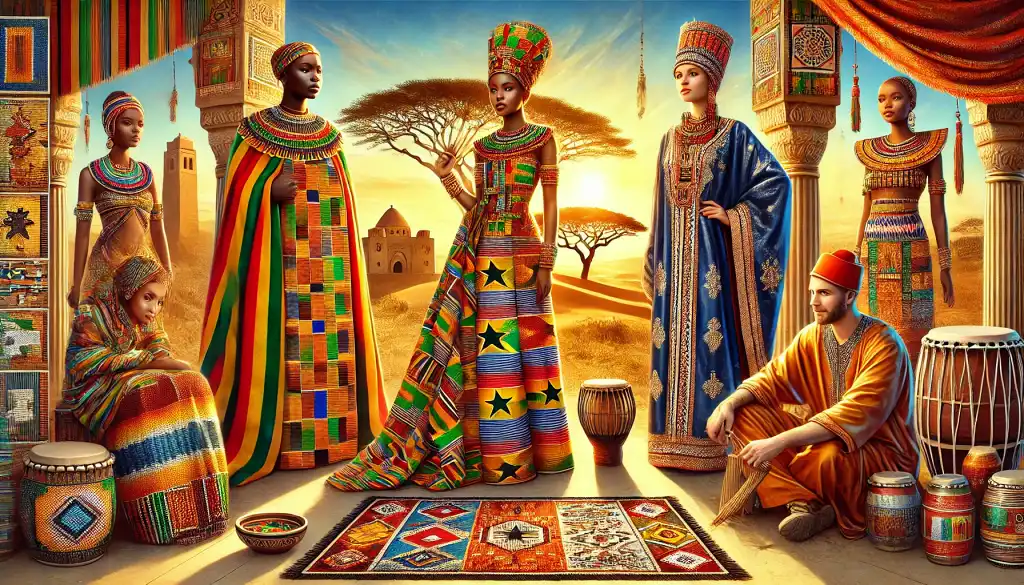
Africa’s diverse landscapes and cultures have given rise to some of the most striking uses of color in fashion. From the warm, earthy tones of the Sahara Desert to the bold, geometric patterns of tribal textiles, African color traditions are deeply symbolic. These colors tell stories of ancestry, community, and spirituality, making African fashion a profound cultural expression.
Today, the global fashion industry continues to draw inspiration from African artistry, reinterpreting traditional techniques in contemporary designs.
West Africa: The Royalty of Kente and Ankara
West Africa is home to some of the continent’s most recognizable textiles, such as Ghana’s kente cloth and Nigeria’s Ankara fabrics.
Kente Cloth: Originally reserved for royalty and sacred ceremonies, kente is woven with vibrant threads of yellow, green, blue, and red. Each color carries meaning—gold represents prosperity, green symbolizes renewal, and red signifies courage and sacrifice. Kente patterns often narrate stories or proverbs, turning every fabric into a wearable piece of history. For example, the “Eban” pattern symbolizes security and safety, reflecting the importance of home and family.Designers like Christie Brown from Ghana have modernized kente in sleek silhouettes and tailored suits, making it accessible for contemporary wardrobes while preserving its heritage.
Ankara Prints: Known for their bold patterns and colors, Ankara fabrics are a staple of Nigerian fashion. Originally introduced through trade with the Dutch, these wax prints were embraced by West Africans for their durability and visual appeal. Today, designers like Lisa Folawiyo transform Ankara into high-fashion garments, from asymmetrical skirts to structured blazers, blending traditional aesthetics with modern luxury.
The popularity of kente and Ankara extends beyond Africa, influencing collections by global brands like Stella McCartney and even appearing in mainstream retail lines.
North Africa: Moroccan Kaftans and Berber Art
North Africa’s fashion draws heavily from its rich history as a crossroads of trade between Europe, Africa, and the Middle East. This is most evident in the luxurious Moroccan kaftans, which have been a symbol of status and elegance for centuries.
Kaftans and Embroidery: Moroccan kaftans are renowned for their intricate gold and silver threadwork, often featuring floral or geometric patterns. The colors—cobalt blue, saffron yellow, and emerald green—are inspired by the natural and architectural beauty of Morocco. For example, Chefchaouen, the famous “Blue City,” is mirrored in the vibrant indigo dyes used in traditional garments.Yves Saint Laurent, who lived in Marrakech for much of his life, frequently incorporated these Moroccan influences into his collections, blending French couture with North African aesthetics.
Berber Tribes: The Berber people, indigenous to North Africa, are known for their bold patterns and striking colors in textiles and jewelry. Red and orange represent protection and fertility, while black signifies strength. Berber rugs and tunics, adorned with these colors, are now prized globally for their craftsmanship.
North African color traditions continue to inspire not only fashion but also home decor, influencing everything from textiles to interior design in Western markets.
South Africa: Zulu Beadwork and Xhosa Aesthetics
Southern Africa’s fashion is characterized by its intricate beadwork and distinctive textile patterns, each steeped in cultural significance.
Zulu Beadwork: Among the Zulu people, bead colors form a symbolic language. Red signifies love and sacrifice, blue represents fidelity, and white embodies purity. These beaded patterns are often used in necklaces, bracelets, and headpieces to convey personal or communal messages.
Xhosa Textiles: The Xhosa people are known for their black-and-white striped fabrics, which have been reinterpreted in modern fashion. South African designer Laduma Ngxokolo, with his brand Maxhosa Africa, has brought Xhosa-inspired knitwear to global runways, combining traditional patterns with bold, modern colors.
The vibrant aesthetic of South Africa has not only influenced African fashion but also contributed to the global “Afro-futurism” movement, which combines cultural heritage with futuristic design.
Europe: Elegance Woven Through Time

Europe stands as a crossroads of cultures and a cradle of artistic innovation, where the interplay of history and geography has forged a fashion legacy like no other. From the gilded courts of France to the windswept highlands of Scotland, colors in European fashion carry whispers of ancestry, tradition, and identity. This continent has long inspired the world with its ability to blend the past with the present, creating timeless elegance.
France: The Language of Sophistication
France, the epicenter of haute couture, has dictated the world’s color palette for centuries. In the Rococo period, the aristocracy reveled in soft pastels—powdery pinks, pale blues, and creamy whites—reflected in the opulent gowns and salons of Versailles. These colors, delicate yet decadent, whispered of luxury and refinement. Fast-forward to the 20th century, and Coco Chanel redefined elegance with her stark, minimalist black dresses, proving that simplicity could exude sophistication. French fashion houses continue this legacy, effortlessly merging pastels with monochromes to maintain their timeless allure.
Scotland: The Soul of the Highlands
Scotland’s rugged landscapes birthed one of the most iconic symbols of European identity: tartans. These intricately woven patterns, rich in earthy greens, deep blues, and vibrant reds, once signified allegiance to clans, acting as a visual tapestry of history. Tartans are more than fabric—they are an expression of unity, strength, and pride. Today, they stride down runways reimagined by designers like Vivienne Westwood, who infuse their rebellious spirit with a sense of tradition. A single tartan tells a thousand stories, its colors evoking Scotland’s misty moors and rushing rivers.
Spain: Passion in Every Thread
Spain’s flair for drama manifests in its bold use of color. The fiery reds and blacks of flamenco dresses, swaying to the rhythm of guitars, are a celebration of life, passion, and intensity. These hues are not confined to the dance floors of Andalusia—they have spilled into couture collections, igniting runways with their unapologetic vibrancy. In Valencia, the golden brocades of traditional falleras gowns shimmer like the sun-kissed Mediterranean, embodying the joy of Spanish festivities. Spanish fashion radiates energy, its colors pulsating with the rhythm of a nation that lives to celebrate.
Italy: A Symphony of Renaissance Tones
Italy breathes art into its every endeavor, and fashion is no exception. From the Renaissance masters who painted with pigments as rich as life itself, to modern designers crafting garments that echo the country’s rolling hills and sparkling coasts, Italy’s color palette sings of its heritage. Tuscan siennas, Venetian golds, and Amalfi blues find their way into flowing silks and tailored suits. Brands like Versace and Gucci embrace bold contrasts, transforming the warmth of Italy’s landscapes into statements of audacious elegance. Every stitch is a brushstroke, painting a picture of a nation in love with beauty.
Eastern Europe: Folklore in Full Bloom
In Eastern Europe, color is a storyteller, and traditional garments are its canvas. The vyshyvanka blouses of Ukraine, embroidered with vivid reds, blues, and greens, are steeped in symbolism—flowers for fertility, wheat for prosperity, and protective motifs to ward off harm. In Hungary, the elaborate patterns of matyó embroidery weave tales of love and life, their colors as bright as the blooms they depict. These folkloric traditions, passed down through generations, have found their way into contemporary fashion, their vibrant hues breathing life into modern designs that bridge the past and the present.
The Nordic Whisper of Nature
In the Nordic countries, colors are subdued, reflective of the region’s serene landscapes and understated elegance. Iceland’s lopapeysa sweaters, knit in shades of ash gray and snowy white, mirror the volcanic terrain and icy peaks. Danish fashion embraces muted tones, prioritizing simplicity and warmth in its pursuit of hygge. The natural dyes of birch bark and indigo root speak to a commitment to sustainability, a philosophy that has made Scandinavian design a beacon of modern minimalism. Here, every shade whispers of the calm, unspoiled beauty of the North.
Europe’s fashion is a kaleidoscope of histories and emotions, a place where colors transcend fabric to become the language of tradition and transformation. Whether through the luxurious pastels of Versailles or the fiery reds of Spain, each hue carries a piece of Europe’s soul, woven into garments that echo across centuries.
The Americas: A Symphony of Vibrance and Resilience
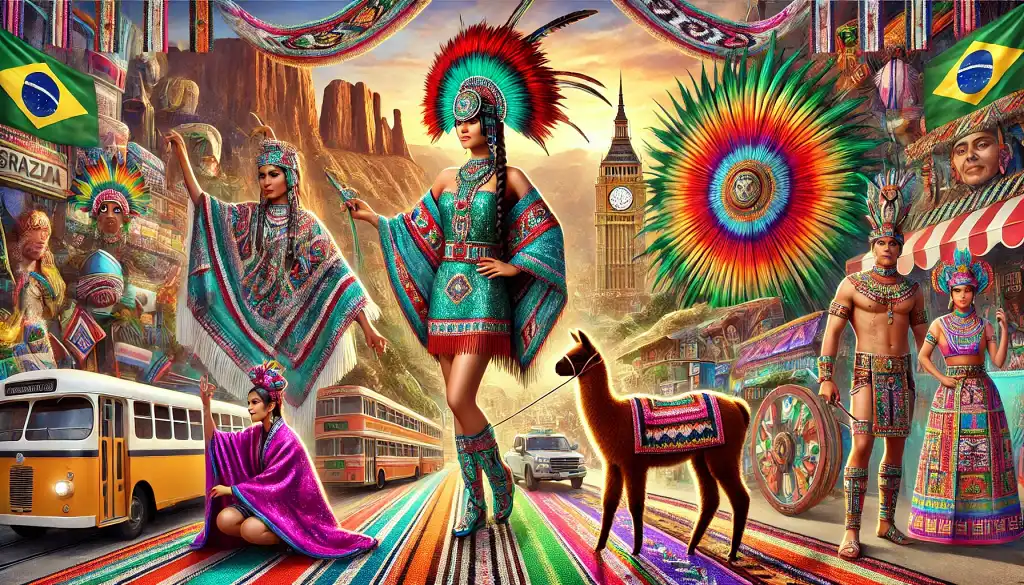
The Americas, a vast tapestry of cultures and histories, offer a breathtaking range of colors and textiles that echo their natural landscapes and cultural narratives. From the icy blues of the Arctic to the fiery reds and golds of the tropics, every shade tells a story. In fashion, these colors have been used not only as decoration but also as powerful symbols of identity, heritage, and resistance. Across North, Central, and South America, color in clothing represents joy, spirituality, and a deep connection to the land.
North America: Roots of Tradition and Modernity
In North America, fashion is deeply tied to the land and its peoples. The indigenous tribes of the United States and Canada were among the first to use color as an expression of identity, with their beadwork and textiles telling rich stories of their connection to nature and community.
Native beadwork, often crafted from vibrant red, turquoise, and yellow, is more than ornamental—it’s a language. Patterns represent family lineage, spiritual beliefs, and the surrounding environment. Moccasins, dresses, and ceremonial regalia adorned with beadwork continue to hold cultural significance, celebrated at powwows and festivals across the continent.
The story of North American fashion would be incomplete without mentioning the influence of the American West. Blue denim, pioneered by Levi Strauss, emerged as a utilitarian fabric for miners and ranchers. It has since become a global fashion staple, symbolizing rebellion, freedom, and casual elegance.
Modern indigenous designers, like Bethany Yellowtail, are reclaiming their heritage in the fashion world. By blending traditional patterns with contemporary silhouettes, they challenge stereotypes and breathe new life into ancient crafts.
Central America: A Cultural Kaleidoscope
In Central America, the art of textile-making is as old as the civilizations that once flourished there. Indigenous communities, such as the Mayans and Aztecs, have long used textiles as a form of storytelling, preserving their histories and beliefs through vivid patterns and bold colors.
Mayan weaving is a masterpiece of craftsmanship, with artisans creating intricate designs on backstrap looms. Colors like deep purple, bright yellow, and fiery red symbolize sacred elements such as maize, the sun, and the cosmos. Each village in Guatemala is known for its distinct patterns, making every piece of fabric a unique expression of local identity.
In Mexico, the serape—a brightly striped, blanket-like shawl—has become a symbol of national pride. The colors of the serape reflect Mexico’s diverse landscapes, from desert sands to lush jungles. Meanwhile, the rebozo, a versatile shawl, embodies both elegance and practicality, often worn during festivals and weddings.
Carla Fernández, a contemporary Mexican designer, has gained international acclaim for her work with indigenous artisans. Her collections celebrate the bold colors and traditional techniques of Central America, transforming them into modern, wearable art.
South America: The Spirit of Celebration
South America’s vibrant cultures and natural wonders have shaped a fashion identity as bold as the region itself. From the highlands of the Andes to the bustling streets of Rio de Janeiro, colors in South American fashion are a celebration of life.
The Andean highlands of Peru and Bolivia are famous for their alpaca and llama wool textiles, dyed in bright yellows, magentas, and blues. These colors are inspired by the flora of the highlands, and traditional garments like ponchos and polleras are adorned with intricate geometric patterns.
Brazil’s Carnival, the world’s most dazzling festival, is a kaleidoscope of sequins and feathers. Costumes explode with electric greens, hot pinks, and shimmering golds, reflecting the energy and joy of Brazilian culture. Designers like Osklen have embraced this vibrancy, using tropical colors and sustainable materials to create collections that capture the spirit of Brazil.
Alessandra Petersen, a Peruvian designer, brings a contemporary edge to traditional Andean designs, combining heritage patterns with modern cuts to create pieces that are both striking and deeply rooted in her culture.
Australia and Oceania: A Tapestry of Nature and Tradition
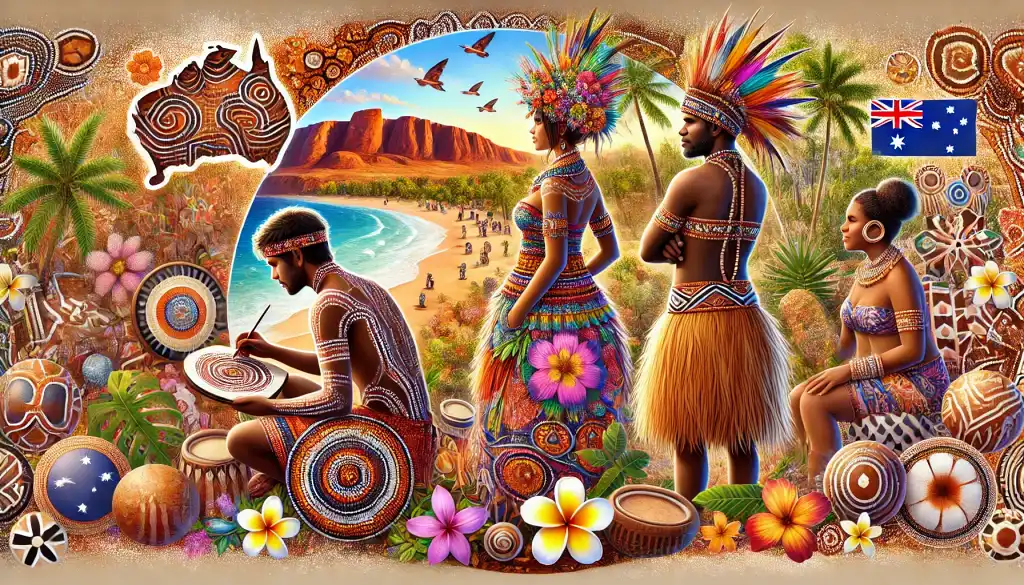
Australia and Oceania, a region defined by its sprawling landscapes and deep ties to the ocean, offers a kaleidoscope of colors and cultural richness in its fashion and traditional attire. From the intricate designs of Aboriginal art to the vibrant patterns of Polynesian tapa cloth, the region’s fashion is a celebration of identity, heritage, and the natural world.
Australia: The Wisdom of the Land
In Australia, Aboriginal art forms the foundation of the country’s cultural identity. Dots, lines, and earthy colors like ochre, red, and black dominate, reflecting the landscapes and stories passed down through generations.
Aboriginal Body Art and Textiles: Traditionally, ochre pigments were used in body painting for ceremonies, symbolizing the connection to land and ancestors. Modern designers like Julie Shaw of Maara Collective transform these motifs into contemporary fashion, using earthy tones and abstract patterns to pay homage to Indigenous culture.
Bush-Inspired Fashion: The natural beauty of Australia—its golden deserts, turquoise waters, and green eucalyptus forests—inspires the color palettes of modern Australian fashion. Designers like Akira Isogawa and Camilla often incorporate these tones into flowing dresses and beachwear, merging tradition with a laid-back coastal vibe.
Polynesia: Patterns of the Ocean
In Polynesia, the ocean is a source of life, and its influence is deeply woven into the region’s fashion. Traditional attire often features bold patterns and vibrant hues inspired by tropical landscapes.
Tapa Cloth: Made from the bark of mulberry trees, tapa cloth is hand-painted with geometric patterns in black, red, and brown. These patterns often symbolize familial ties and historical events. In Samoa, Tonga, and Fiji, tapa is still used during ceremonies and celebrations, reflecting the cultural significance of these designs.
Hawaiian Prints: The iconic Hawaiian shirt, or aloha shirt, is a global symbol of tropical leisure. Its bright floral patterns in shades of pink, yellow, and green echo the lush flora of the islands. Originally inspired by Japanese textiles, the aloha shirt has evolved into an enduring piece of casual fashion.
Melanesia and Micronesia: Echoes of Tradition
Melanesian and Micronesian cultures showcase their vibrant traditions through stunning body art and ceremonial attire.
Shells and Feathers: In Papua New Guinea, traditional costumes are adorned with shells, feathers, and beads in bright colors, symbolizing status and connection to nature. These elements are incorporated into headdresses and necklaces, creating striking visual statements.
Natural Dyes: Micronesian weavers use natural dyes to create colorful mats and garments. Shades of green, yellow, and red dominate, reflecting the lush, tropical environment.
Modern fashion in this region blends traditional techniques with contemporary designs, creating a harmonious balance of heritage and innovation.
The Middle East: A Canvas of Luxury and Tradition
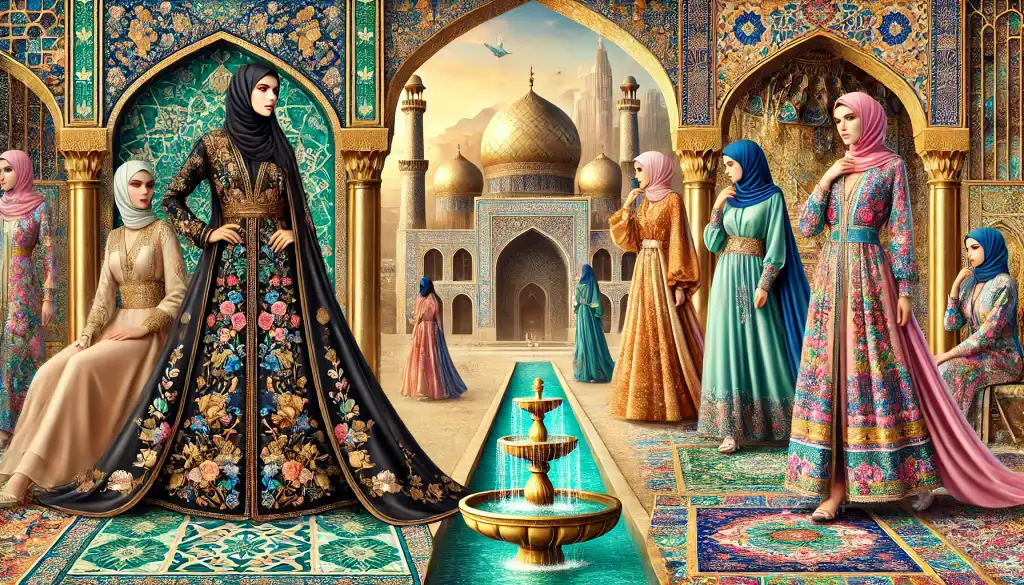
The Middle East is a land where history and tradition intertwine with innovation and artistry, creating a rich tapestry of cultural expression. Fashion in this region is not merely about garments – it is a reflection of faith, identity, and the vibrant landscapes that inspire its people. From the shimmering golds of the Arabian deserts to the intricate patterns of Persian embroidery, every thread and hue tells a story.
The Role of Modesty and Elegance
In many Middle Eastern cultures, modesty is not just a value – it is an art form. Garments like the abaya, hijab, and chador symbolize spirituality and cultural heritage while allowing for personal expression through design, texture, and color.
The hijab, often worn in muted tones like black, beige, or white, has become a symbol of modest fashion. Today, modern interpretations showcase vibrant patterns, delicate embroidery, and luxurious fabrics. It is a powerful statement of identity, blending tradition with contemporary aesthetics.
The abaya, traditionally black, has evolved into a canvas for creativity. Designers craft abayas in rich jewel tones, soft pastels, and even metallic hues, often adorned with intricate gold or silver embroidery. These garments are both practical and luxurious, capturing the region’s essence of understated elegance.
Persia (Iran): A Symphony of Patterns
The elegance of Persian culture is unmatched, with its intricate patterns and vibrant colors found in everything from ancient carpets to traditional garments. Persian fashion draws heavily from its rich artistic heritage, where jewel tones like emerald green, ruby red, and sapphire blue symbolize prosperity and vitality.
Traditional Persian robes, often crafted from luxurious silks, feature floral and paisley motifs that reflect a deep connection to nature. These designs were staples of the Safavid dynasty and remain timeless symbols of Persian refinement.
Modern Iranian designers, such as Hoda Katebi, reinterpret these elements, blending heritage patterns with contemporary silhouettes to create pieces that resonate worldwide.
Jewelry, Henna, and Accessories
In Middle Eastern fashion, accessories bring vibrancy to even the simplest garments. Gold is the most revered material, with necklaces, earrings, and bangles adding richness and warmth to traditional attire. Often, these pieces carry symbolic meanings, reflecting themes of protection, prosperity, and love.
Henna is another cherished art form, applied during weddings and celebrations. The intricate designs, ranging from floral motifs to geometric patterns, add earthy reds and browns to the visual language of the Middle East.
Even the simplest niqabs or hijabs are often adorned with subtle embellishments, such as Swarovski crystals or intricate beadwork, offering a delicate touch of luxury.
Modern Modest Fashion
Middle Eastern fashion is a profound expression of identity, faith, and history, woven together with threads of elegance and tradition. From the modest yet opulent abayas of the Arabian Peninsula to the intricately embroidered Palestinian thobes and the vibrant jewel tones of Persian garments, the region’s attire reflects a deep connection to its rich heritage and natural landscapes.
The Middle East has masterfully balanced modesty with creativity, transforming garments like the hijab, chador, and abaya into symbols of individuality and cultural pride. Accessories such as gold jewelry and intricate henna designs add layers of symbolism and artistry, enhancing even the simplest attire. The fusion of ancient techniques with modern innovations by designers like Reem Acra, Rabia Z, and Hoda Katebi highlights the region’s ability to evolve while honoring its roots.
This region’s influence on the global modest fashion movement underscores its role as a leader in redefining beauty and style. The Middle East continues to inspire with its luxurious, intricate, and timeless approach to fashion, leaving an indelible mark on the world stage. Its vibrant colors, meticulous craftsmanship, and cultural depth make it a true canvas of tradition and modernity.
Fashion as a Global Language of Identity and Innovation
Fashion, in its endless diversity, is a powerful storyteller that bridges time, geography, and culture. From the delicate silks of Asia to the vibrant textiles of Africa, the elegant tailoring of Europe, the bold creativity of the Americas, and the opulent modesty of the Middle East, the world’s fashion traditions are a celebration of identity, heritage, and innovation.
A Kaleidoscope of Cultures
Each region offers a distinct perspective on the role of clothing in human life:
Asia wows with its intricate craftsmanship, where garments like the Japanese kimono or Indian sari embody centuries of artistry and spiritual meaning.
Africa bursts with colors and patterns that narrate stories of ancestry, celebration, and resilience, with textiles like Kente cloth and Ankara prints serving as cultural symbols.
Europe reflects refinement and versatility, where centuries-old traditions such as Scottish tartans or French haute couture continue to inspire modern creations.
The Americas embrace vibrant storytelling through fashion, from the beaded moccasins of Native Americans to the carnival costumes of Brazil.
The Middle East seamlessly fuses modesty and luxury, with garments like embroidered abayas or Persian robes showcasing both spiritual devotion and artistic flair.
The Influence of Cross-Cultural Exchange
Fashion is not confined by borders—it evolves through interaction, trade, and shared creativity. Throughout history, cultural exchange has shaped the global fashion landscape:
The Silk Road introduced Asian silks, dyes, and patterns to Europe, influencing luxury fashion in the Renaissance and beyond.
Africa’s trade routes brought bold textiles and beading techniques to the Americas and Europe, leaving a lasting legacy.
European colonial influences, while complex, introduced Western tailoring to regions like India and the Middle East, resulting in fascinating blends of traditional and modern styles.
In the 21st century, globalization and digital media have enabled the rise of global trends, where designers draw from diverse traditions to create collections that resonate across cultures.
Modern fashion celebrates these interwoven influences, demonstrating how cultural exchange enriches the global aesthetic. Today, a runway in Paris might feature African beadwork, Middle Eastern embroidery, and Japanese-inspired silhouettes—all while honoring their origins.
Fashion as a Universal Celebration
The evolution of fashion is a testament to humanity’s creativity and adaptability. Every garment, from ceremonial robes to everyday attire, reflects a deep connection to the past while embracing the future. As designers continue to innovate, the traditions and narratives of cultures worldwide remain their foundation, ensuring that fashion remains a vibrant and universal expression of the human experience.
In this interconnected world, fashion has become a bridge—uniting people, preserving heritage, and inspiring beauty in diversity. It is a language we all speak, woven together by the threads of identity, creativity, and shared humanity.
